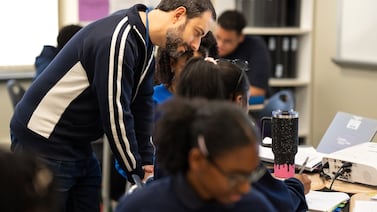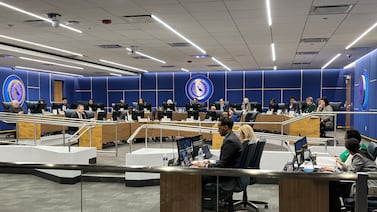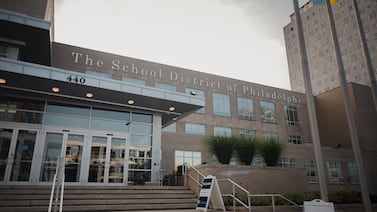Chalkbeat is a nonprofit news organization covering public education in communities across America. Subscribe to our free Colorado newsletter to keep up with how public education is changing: ckbe.at/subscribe-colorado
For the past two years, school districts were able to provide free meals for all students after the federal government waived income eligibility requirements, About 20% more Colorado children – roughly 68,000 statewide – were eating meals at schools.
But those pandemic waivers expired this fall, and districts once again are requiring families to fill out forms to determine if their students qualify for free or reduced-price meals. The number of kids eating at school is already dropping, officials say.
Now, a measure on the Nov. 8 ballot will allow Colorado voters to decide whether to bring back school meals for all students.
Under Proposition FF, taxpayers making more than $300,0000 would pay more taxes so that school districts could opt in to serve meals for free to all students. Districts would have to participate in some federal programs first to get as many federal dollars as possible, but the state would cover all costs the federal programs don’t.
“Kids had better nutritious meals in schools, they didn’t have to resort to going hungry. We already saw what it does,” said Ashley Wheeland, director of public policy for the nonprofit Hunger Free Colorado. “Everyone knows kids need food to learn.”
The school lunch program determines eligibility by using federal poverty guidelines that aren’t adjusted depending on the state. In Colorado, where the cost of living is high, proponents of Proposition FF believe there are children who don’t qualify for subsidized meals, but whose families still struggle to pay for healthy food.
Colorado renters are cost-burdened — spending 30% or more of their income on housing costs — at the eighth highest rate in the country, according to one study reported by the Denver Post.
This year, a family of four must be making under $51,338 to qualify for subsidized meals under federal guidelines. A family of four in Colorado needs $73,132 to meet basic needs, according to the Massachusetts Institute of Technology’s living wage calculator.
Danielle Bock, director of school nutrition in Greeley-Evans District 6, said that she’s talked to families who earn just above the limit and still need help. Sometimes they calculate that if they were to subtract the amount they have to spend on full-price lunches every day for their kids from their income, they would qualify for the subsidized meals.
Unfortunately, what families spend is not a part of the calculation, Bock said.
If approved, Proposition FF would operate as a grant program for school districts that choose to participate. They would have to opt in to federal programs to ensure they’re getting as many federal dollars as possible first, and the state would make up the difference.
If all districts participate, the measure is expected to cost around $100 million per year once it’s fully operational, and a little more in the first year. It would be paid for by limiting how many state tax deductions taxpayers who make more than $300,000 can claim, essentially taxing them more. According to a state fiscal analysis, the tax measure is expected to bring in $100.7 million in the budget year 2023-24, and increasing amounts each year after.
How it would work
Colorado already picks up the extra cost of meals for students who qualify for reduced-price meals, making them free to families.
This year, legislators proposed a state law to expand that so the state budget would cover the cost for all students not eligible for subsidized meals, but the proposal didn’t pass. Legislators who opposed the bill were concerned about the cost, and wondered if the money wasn’t better spent elsewhere.
At least two other states, California and Maine, have passed legislation to create free school meals for all students. A few others are running pilot programs or have raised the eligibility levels so more students would qualify, something that traditionally states have not adjusted.
Colorado has already applied for permission to use Medicaid as a way to directly qualify students who receive that benefit, even if their families don’t fill out the required free lunch forms. School lunch operators believe that if school districts are able to use Medicaid data to qualify students, fewer children will fall through the cracks.
The measure also requires eligible districts to apply for and operate the Community Eligibility Provision program. That program allows a district to stop asking families to fill out a free lunch eligibility form, and gives districts more federal money. In exchange, the district commits to providing free meals to any student.
Depending on the percentage of eligible students, the federal money may be enough to cover the whole program, but not necessarily in all cases. Under Proposition FF, when it’s not enough, the state money would cover the difference.
In other cases, an entire district might not qualify for the program, but a subset of schools would, and the district would have to operate some schools with the program and some without.
Erika Edwards, the public policy and legislation chair for the Colorado School Nutrition Association, said her association had some concerns about the challenges for districts, but still has signed on to support the proposition.
“I would assume there are some districts it’s not going to make sense for, but that number is probably small,” Edwards said.
Another possible challenge, Edwards said, is that when meals are free for all students, more eat the meals, requiring districts to have the capacity to make more food. With staff shortages, that can be difficult.
The proposition also looks to address some of those problems, but that would not happen in the first year.
The grants to allow free school meals would begin in the 2023-24 school year. In 2024-25, the state would also provide extra money through grants to allow districts to purchase local Colorado food for meals, help provide stipends for lunch employees, and receive training, equipment, or assistance from a nonprofit to prepare healthy school meals.
One district is already finding its own way
Advocates for the measure have already raised more than $1.5 million dollars to help pass the measure. No organized opposition is raising money. Still some people have raised objections about the proposition, including noting that it raises taxes for about 113,988 taxpayers, or less than 5% of the state’s estimated taxpayers, and that the money may also pay for the lunches of some children whose families can afford food.
Bock worries that if the ballot measure were to fail, it might discourage legislators from attempting another fix.
Still, advocates are hopeful that if passed, the measure will allow more children to eat a good meal at school. That, in turn, would help students be better prepared to learn.
“I want all of our students to eat at school,” Bock said. “There isn’t a healthier meal in a child’s day.”
In Greeley’s District 6, Bock said, leaders started looking for a way to keep school meals free for all before the school year started, when it seemed clear the federal government was going to eliminate waivers.
Bock estimated that her program needed $2 million to continue free lunches for this year, and the school board unanimously approved the allocation of that money.
Still, this year, the district, like others, has pushed families to fill out eligibility forms. Bock said the district has collected more forms “than ever in history.” Only about 2,000 out of 23,000 families have not filled out a form this year, she said. Usually around 8,000 families skip the forms.
That is one other reason she said she knows families need the help.
For next year, even if the ballot measure doesn’t pass, Bock is hoping to be able to continue offering free school meals. If the state receives permission to directly qualify students who receive Medicaid benefits, she expects it should change the district’s percentages enough so that using the Community Eligibility Provision program may cover all the costs of free meals.
If so, the measure might not be helpful to her district. Still, she helped work on it earlier on, because she believes it will help others.
“I know there are districts in Colorado that it would benefit,” Bock said. “For me it’s about changing the perception of what school meals are and trying to move us to a society that sees school meals as a regular part of the school day that doesn’t require an application.”
She and other advocates say one of the big benefits of universal free school meals is that it removes the stigma of poverty associated with eating a school meal.
Wheeland from Hunger Free Colorado says that stigma also contributes to about 40% of the students who qualify for free or reduced-price lunches still not eating a lunch at school.
Bock wants eating a school meal to be as normal as students reading in a school library.
“You see a student in the library, reading a book, you don’t say, ‘oh that poor child has no books at home,’” Bock said.
Yesenia Robles is a reporter for Chalkbeat Colorado covering K-12 school districts and multilingual education. Contact Yesenia at yrobles@chalkbeat.org.






